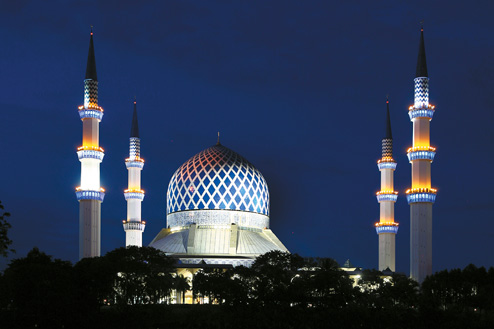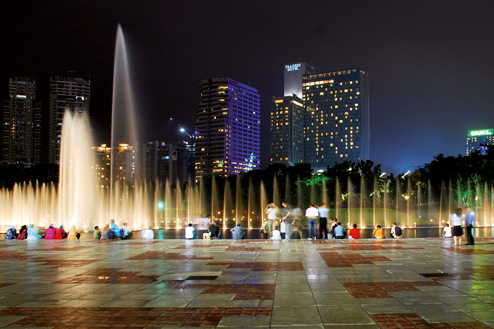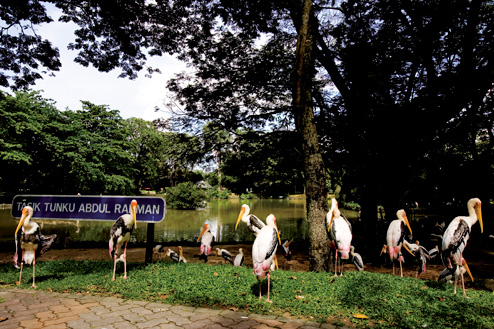Putrajaya
While Kuala Lumpur is Malaysia’s capital city, Putrajaya, founded only in 1995, is its administrative centre. Lying 25 kilometres south of KL and roughly halfway on the route to Kuala Lumpur International Airport, this purpose-built municipality is an architectural masterpiece. Situated on 12,000 acres of land, it is well worth a daytrip if only to marvel at its many striking buildings conceived and built entirely by Malaysian enterprises and reflecting a very Malaysian aesthetic.
Putrajaya is divided into a number of precincts, the most important being at the city’s centre. They are called Government, Commercial, Civic and Cultural, Sports and Recreation and Mixed Development. The land area of the city is huge and attractions are spread out, so being familiar with which precincts are home to the various sights you wish to visit is essential. In addition to the core precincts, there are another 15, most of which are residential.
Any visitor to Putrajaya should see the Prime Minister’s Office complex and the nearby Putra Mosque. The mosque is massive and can accommodate up to 15,000 people for prayers. It contains a museum, a library, an exhibition hall and an auditorium, as well as the main prayer area itself. Built on five levels, the mosque is a visual message to the faithful. The levels represent both the five pillars of Islam and the five daily calls to prayer.
The blue-domed prime minister’s residence next to it is also impressive and reflects a number of architectural influences, although both the arches and onion-shaped domes are unmistakably modern Islamic.
Some criticism has been levelled at the architecture of Putrajaya, claiming it is too exclusively Islamic. Since Malaysia is multi-ethnic, say the critics, where are the buildings reflecting Chinese, Indian, western and even modern Malay influences? You will need to judge for yourself whether or not this criticism is justified, but even the untrained eye is likely to uncover a wide number of cultural styles in the city’s fabulous buildings.
Putrajaya is one of Malaysia’s three federal territories, the other two being Kuala Lumpur itself and the island of Labuan. The eventual population goal for the city is 300,000 people: at present it is only about a sixth of the way there. Given the vast area of Putrajaya it is little wonder that the city’s streets often feel quite empty.
The city is built around a huge waterway, Putrajaya Lake, which afforded the designers the opportunity to construct a total of nine bridges, some of which are visually quite stunning. Most notable among these are the 370 metre-long Seri Perdana Bridge and the two-tiered Putra Bridge.
Putrajaya was designed to be beautiful not only in terms of its architecture, but also its setting. The gently rolling landscape of the city has been carefully groomed to preserve its natural character. Botanical gardens, parks and wetlands adorn the city. Most visitors stop off at the Wetland Park to explore its 800 acres of marsh which are home to dozens of indigenous plants and fish. In addition to opportunities for birdwatching, the park also offers picnic areas and marked trails for biking, walking and jogging. After spotting such inhabitants as the little egret, the little green heron and the cinnamon bittern, visit the Nature Interpretation Centre to see its wetland diorama and handicraft displays.
No trip to Putrajaya is complete without a love boat ride at the Putrajaya Lake. A number of different tours are also available, and some offer dinner and cocktails.
Putrajaya is divided into a number of precincts, the most important being at the city’s centre. They are called Government, Commercial, Civic and Cultural, Sports and Recreation and Mixed Development. The land area of the city is huge and attractions are spread out, so being familiar with which precincts are home to the various sights you wish to visit is essential. In addition to the core precincts, there are another 15, most of which are residential.
Any visitor to Putrajaya should see the Prime Minister’s Office complex and the nearby Putra Mosque. The mosque is massive and can accommodate up to 15,000 people for prayers. It contains a museum, a library, an exhibition hall and an auditorium, as well as the main prayer area itself. Built on five levels, the mosque is a visual message to the faithful. The levels represent both the five pillars of Islam and the five daily calls to prayer.
The blue-domed prime minister’s residence next to it is also impressive and reflects a number of architectural influences, although both the arches and onion-shaped domes are unmistakably modern Islamic.
Some criticism has been levelled at the architecture of Putrajaya, claiming it is too exclusively Islamic. Since Malaysia is multi-ethnic, say the critics, where are the buildings reflecting Chinese, Indian, western and even modern Malay influences? You will need to judge for yourself whether or not this criticism is justified, but even the untrained eye is likely to uncover a wide number of cultural styles in the city’s fabulous buildings.
Putrajaya is one of Malaysia’s three federal territories, the other two being Kuala Lumpur itself and the island of Labuan. The eventual population goal for the city is 300,000 people: at present it is only about a sixth of the way there. Given the vast area of Putrajaya it is little wonder that the city’s streets often feel quite empty.
The city is built around a huge waterway, Putrajaya Lake, which afforded the designers the opportunity to construct a total of nine bridges, some of which are visually quite stunning. Most notable among these are the 370 metre-long Seri Perdana Bridge and the two-tiered Putra Bridge.
Putrajaya was designed to be beautiful not only in terms of its architecture, but also its setting. The gently rolling landscape of the city has been carefully groomed to preserve its natural character. Botanical gardens, parks and wetlands adorn the city. Most visitors stop off at the Wetland Park to explore its 800 acres of marsh which are home to dozens of indigenous plants and fish. In addition to opportunities for birdwatching, the park also offers picnic areas and marked trails for biking, walking and jogging. After spotting such inhabitants as the little egret, the little green heron and the cinnamon bittern, visit the Nature Interpretation Centre to see its wetland diorama and handicraft displays.
No trip to Putrajaya is complete without a love boat ride at the Putrajaya Lake. A number of different tours are also available, and some offer dinner and cocktails.













